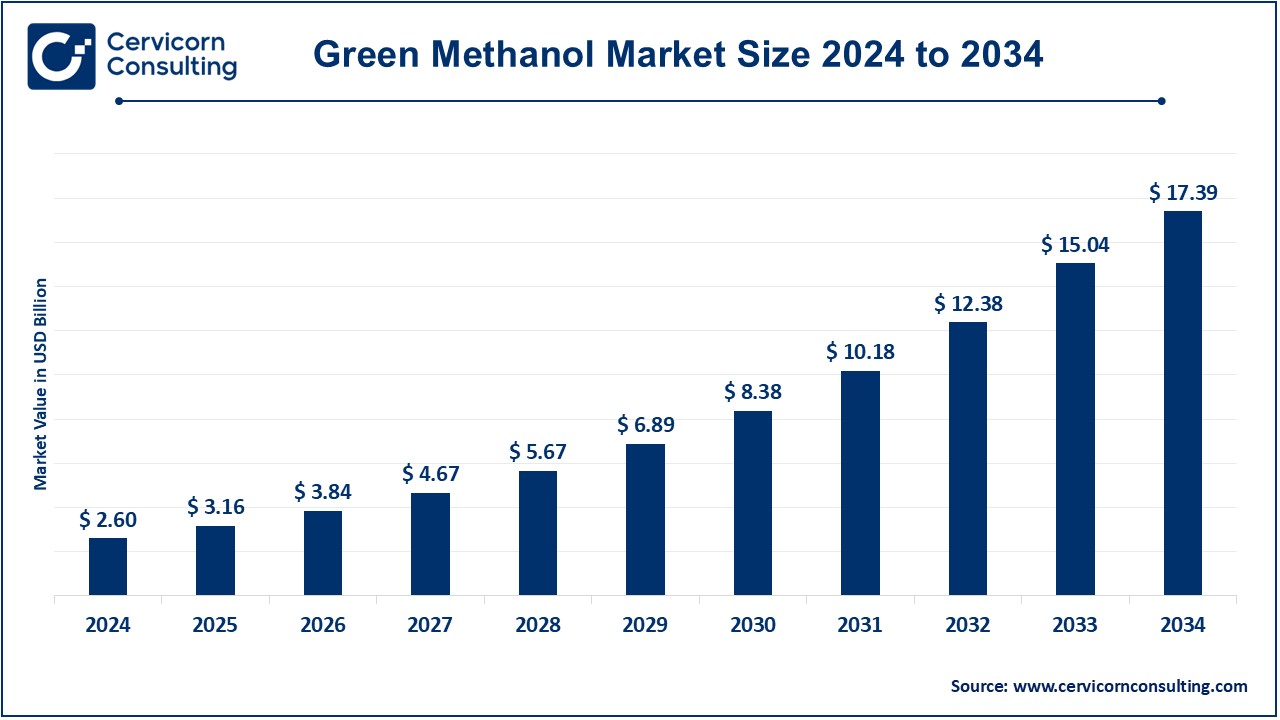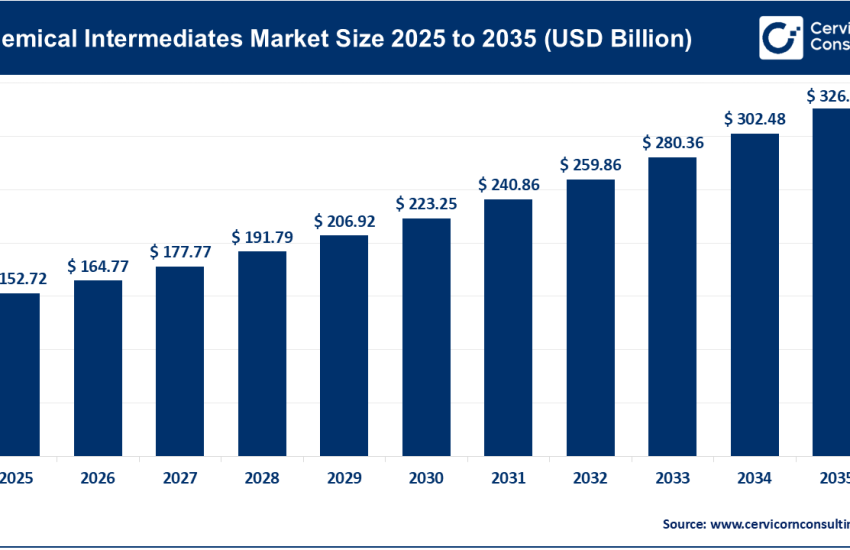Green Methanol Market Growth, Trends, and Key Companies by 2034
Green Methanol Market Overview
The global green methanol market was valued at an estimated USD 0.40 billion in 2024 and is expected to increase to USD 135.84 billion by 2034, with a compound annual growth rate (CAGR) of 79.1%.
The growth of the market is driven by several key factors, including increasing global demand for sustainable energy solutions, the urgent need to reduce carbon emissions across industries, and the growing adoption of green fuels in sectors like shipping, chemicals, and transportation. Technological advancements in carbon capture and renewable hydrogen production have made green methanol more economically viable, while supportive government policies and incentives are further accelerating investment in green methanol projects. Additionally, the transition to a low-carbon economy and the push for carbon-neutral alternatives in industrial applications continue to fuel the market’s expansion.
What is the Green Methanol Market?
The green methanol market refers to the production, distribution, and consumption of methanol produced through renewable sources, unlike traditional methanol derived from fossil fuels. Green methanol, often referred to as renewable methanol or e-methanol, is produced by utilizing carbon dioxide (CO2) captured from the atmosphere, renewable hydrogen produced through electrolysis, and biomass feedstocks. The process reduces the reliance on fossil fuels, aligning with the global push for sustainability and the reduction of greenhouse gas emissions.
Green methanol plays a crucial role in decarbonizing multiple sectors, including maritime transport, chemicals, and energy production. Its key feature is its potential to replace traditional methanol, which is used in the production of fuels, chemicals, and plastics, with a renewable and carbon-neutral alternative. The production of green methanol supports the transition to a low-carbon economy and offers a versatile solution to mitigate climate change.
Why the Green Methanol Market is Important?
The importance of the Green Methanol Market lies in its potential to play a significant role in the global effort to reduce carbon emissions. Methanol is a key building block in the chemical industry, and its use in fuel and energy applications is widespread. Traditional methanol production, which relies heavily on natural gas and coal, generates substantial amounts of CO2. In contrast, green methanol production is designed to absorb CO2 through the synthesis process, making it a carbon-neutral option when compared to conventional methods.
The growing need to meet international climate targets, such as the Paris Agreement, has sparked interest in clean and renewable alternatives across industries. Green methanol provides an alternative to the use of fossil fuels, especially in sectors like shipping and aviation, which are challenging to decarbonize with other technologies. Additionally, the fuel can be integrated into existing infrastructure, making it easier to adopt and scale.
The renewable nature of green methanol also offers a significant opportunity to address carbon emissions in industries that are heavily dependent on chemicals, including fertilizers, plastics, and solvents. By using green methanol, these industries can reduce their carbon footprints and contribute to global sustainability goals.
Get a Free Sample: https://www.cervicornconsulting.com/sample/2315
Leading Companies in the Green Methanol Market
Several companies are at the forefront of the Green Methanol Market, driving innovation and large-scale adoption of renewable methanol across various applications.
Methanex Corporation
Specialization: Methanex Corporation is the world’s largest supplier of methanol. The company operates in the production and marketing of methanol for various industrial applications, including automotive, textiles, plastics, and paints. Methanex is expanding its reach into green methanol production as part of its sustainability efforts.
Key Focus Areas: Methanex’s key focus is on sustainable methanol production through renewable resources. They have committed to reducing their carbon emissions and are exploring new technologies for producing green methanol.
2023 Revenue (approx.): $6.5 billion
Market Share (approx.): 20%
Global Presence: Methanex has operations across North America, Europe, Asia, and South America.
OCI Global
Specialization: OCI Global is a leading producer of methanol and other chemicals, including fertilizers. The company has focused on green methanol by utilizing carbon capture and renewable hydrogen in its production processes.
Key Focus Areas: OCI Global has invested in carbon capture and storage (CCS) technologies and renewable energy integration to produce low-carbon methanol. It focuses on advancing its green methanol production capacity to meet the growing demand.
2023 Revenue (approx.): $8 billion
Market Share (approx.): 10%
Global Presence: OCI operates primarily in North America, Europe, and the Middle East.
Haldor Topsoe A/S
Specialization: Haldor Topsoe is a Danish company known for its expertise in catalysis and chemical production. The company has developed advanced technologies for producing green methanol through CO2 capture and renewable hydrogen.
Key Focus Areas: Haldor Topsoe focuses on innovation in renewable energy and carbon capture. Its proprietary technologies are used to enhance green methanol production efficiency and reduce costs.
2023 Revenue (approx.): $2 billion
Market Share (approx.): 8%
Global Presence: Haldor Topsoe operates globally, with manufacturing facilities and offices across Europe, Asia, and North America.
Proman AG
Specialization: Proman AG is involved in the production of methanol and associated services. The company is increasingly focusing on green methanol production to support the global energy transition.
Key Focus Areas: Proman’s emphasis is on building projects that enable the production of sustainable methanol, including collaborating with industry players to advance green methanol technology.
2023 Revenue (approx.): $1.5 billion
Market Share (approx.): 5%
Global Presence: Proman has a global presence with operations in Europe, North America, and the Middle East.
Carbon Clean Solutions
Specialization: Carbon Clean Solutions specializes in carbon capture technologies, providing solutions to industrial sectors for reducing their CO2 emissions. They focus on developing technologies for converting CO2 into green methanol.
Key Focus Areas: The company’s primary focus is on capturing carbon from industrial processes and utilizing it to produce green methanol, reducing the carbon intensity of traditional industries.
2023 Revenue (approx.): $100 million
Market Share (approx.): 1%
Global Presence: Carbon Clean operates globally, with a strong presence in Europe and Asia.
Leading Trends and Their Impact
1. Technological Advancements in CO2 Capture
The integration of carbon capture technologies into the green methanol production process has been one of the most transformative trends in the market. By capturing CO2 emissions from industrial sources and repurposing them into methanol, companies can produce carbon-neutral methanol. This trend has significantly reduced the cost of green methanol production, making it more competitive with traditional methods.
Impact: This trend accelerates the adoption of green methanol in industries such as chemicals, shipping, and automotive, helping reduce their carbon footprint.
2. Increased Investment in Renewable Hydrogen
The growth of green hydrogen production has also contributed to the expansion of the green methanol market. Renewable hydrogen is produced using solar, wind, or hydropower energy, and it serves as a critical feedstock in the production of green methanol.
Impact: The increase in hydrogen production capacity has enhanced the commercial viability of green methanol and is expected to drive its adoption across various sectors.
3. Decarbonization of the Maritime Industry
The maritime sector is one of the largest contributors to global carbon emissions. As international regulations become stricter on emissions, there is a growing demand for alternative fuels, including green methanol.
Impact: Green methanol’s compatibility with existing maritime infrastructure makes it an attractive alternative fuel for ships. Leading shipping companies are exploring green methanol as a viable option for reducing their carbon emissions.
4. Policy Support and Incentives
Governments worldwide are introducing policies to encourage the adoption of green fuels, including green methanol. This includes providing financial incentives, grants, and tax breaks to companies investing in green methanol production technologies.
Impact: Government support helps make green methanol production more economically viable and fosters innovation in the sector, boosting market growth.
Regional Analysis: Government Initiatives and Policies Shaping the Market
Europe
Europe is one of the leading regions in the development and adoption of green methanol. The European Union has set ambitious targets to achieve carbon neutrality by 2050, and green methanol is seen as a key enabler of these goals. The EU’s Green Deal and its emphasis on carbon-neutral energy sources have led to increased investments in renewable methanol production technologies.
Governments across Europe are supporting green methanol through various subsidies and regulations aimed at reducing emissions in sectors like transportation and manufacturing. Additionally, Europe’s strong emphasis on renewable hydrogen production supports the growth of green methanol production capacity.
North America
The United States and Canada are actively pursuing green methanol production, focusing on integrating carbon capture and renewable energy sources. Both countries have implemented tax incentives for renewable energy investments and are exploring green methanol as a fuel for reducing emissions in shipping and heavy industries.
In the U.S., the Inflation Reduction Act provides substantial funding for projects related to carbon capture and clean hydrogen, both of which are critical for green methanol production. Canada’s commitment to a net-zero emissions future is driving investments in green energy technologies, including methanol production.
Asia-Pacific
Asia-Pacific is a rapidly growing market for green methanol, with countries like China, Japan, and South Korea investing heavily in green fuel technologies. China’s focus on reducing carbon emissions has resulted in substantial investments in green hydrogen production, which supports the green methanol industry.
Japan and South Korea are also at the forefront of using green methanol in the shipping industry, with large-scale projects underway to integrate green methanol into their fleets. Government initiatives in these countries focus on reducing fossil fuel dependence and promoting the use of sustainable fuels.
Middle East and Africa
The Middle East is traditionally known for its vast reserves of oil and gas, but several countries in the region are now shifting towards renewable energy solutions, including green methanol. Saudi Arabia and the UAE are investing in carbon capture and storage technologies, while also exploring renewable hydrogen production.
In Africa, green methanol is gaining attention as a potential solution for sustainable energy access and emissions reduction. However, the market remains in the early stages of development, with government support and investments still evolving.
To Get Detailed Overview, Contact Us: https://www.cervicornconsulting.com/contact-us
Read Report: Materials Informatics Market Trends, Top Companies, and Insights 2024 – 2033



